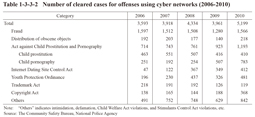Section 3 High-Technology Offenses
1 Trends in high-technology offenses
Table 1-3-3-1 shows the number of cleared cases for offenses involving computers or electromagnetic records (unauthorized creation or damaging of electromagnetic records, etc., obstruction of business by damaging a computer, etc., and computer fraud), offenses related to the electromagnetic records of payment cards, and Unauthorized Computer Access Act violations over the last five years. Unauthorized Computer Access Act violations were sharply increasing from 2005, with the number of cleared cases being 1,601 (down 36.8% from the previous year) and the number of persons cleared 125 (up 9.6% (id.)) in 2010 (Source: The Community Safety Bureau, National Police Agency).
Table 1-3-3-1 Number of cleared cases for offenses involving computers or electromagnetic records, etc. (2006-2010)
Table 1-3-3-2 shows the number of cleared cases for offenses using cyber networks (offenses using cyber networks including fraud over the internet and child prostitution cases, etc.) over the last five years. The number of cleared cases for offenses using cyber networks was on an increasing trend, and was 5,199 in 2010 (up 31.3% from the previous year). By type of offense, the number of cleared cases for fraud remained at a high level from 2005 and was 1,566 in 2010 (up 22.3% from the previous year). Of fraud cases 677 (43.2%) involved offenses related to internet auctions (Source: The Community Safety Bureau, National Police Agency). The number of cleared cases for sexual offenses against children was on an increasing trend. In 2010 the number of cleared cases for child pornography and that of Youth Protection Ordinance violations increased by 54.4% and 47.5%, respectively, from the previous year. The number of cleared cases for Internet Dating Site Control Act violations also increased by 18.1% from the previous year in 2010.
Table 1-3-3-2 Number of cleared cases for offenses using cyber networks (2006-2010)
Reference: Status of report concerning computer viruses
The spread of computer viruses has been a factor in the obstruction of the smooth processing of information by computers.
Those who discovered a computer virus or were infected with it are requested to report it to the Information-technology Promotion Agency, Japan. Table 1-3-3-3 shows the number of reported cases of computer viruses over the last 10 years.
Table 1-3-3-3 Number of reported cases of computer viruses (2001-2010)
A revision of the Penal Code, etc. on June 17, 2011 (by Act No. 74 of 2011) created a new offense of the illegal creation of unauthorized command for electromagnetic records, etc. (creation/provision of so-called computer viruses, etc.) and expanded the acts subject to penalty for distribution of obscene objects, etc. (act of distribution of obscene electromagnetic records through transmission of telecommunications, etc.) (enforced on July 14, 2011).


